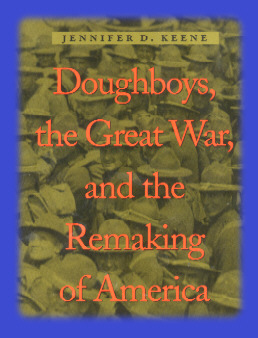A Special Contribution Courtesy of
Jennifer D. Keene & The Johns Hopkins University Press
Why is World War I important in American history? Quite simply, the Great War generation played a critical role in constructing the modern U.S. Army, turning World War II soldiers into the most privileged veteran generation in American history and determining what mass military service would mean for millions of American men throughout the twentieth century . . . [From the introduction] 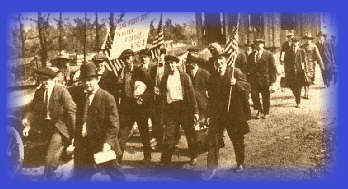 Doughboys To Be: Reporting for DutyOnce the United States had entered World War II, ensuring that history did not repeat itself became the primary objective both of the U.S. Army and of Great War veterans. To learn from its past experiences with conscripted civilians, the General Staff ordered a series of studies of the army's previous experience with black soldiers, courts-martial, relations between American and Allied soldiers, collecting soldiers' votes, desertions, and demobilization. Hoping to avoid the psychiatric breakdowns observed among shell-shocked soldiers during the Great War, the army at first tried to weed out (through induction center rejections or discharges) those who seemed predisposed to mental breakdowns. Eventually realizing that this practice created a way, so feared at the beginning of World War I, for malingerers to avoid military service, the army then reverted to the battlefield treatments used effectively twenty-five years earlier. Picking up where the Morale Division had left off in 1919, the soldiers' opinion studies undertaken by Samuel Stouffer and his colleagues in the Research Branch of the Information and Education Division of the War Department provide some clues about how much influence civilian soldiers wielded within the new wartime army. The Stouffer studies were vastly more sophisticated than the rudimentary efforts of previous morale investigators, but their intent was the same. Hoping to perfect the collaboration between citizen-soldiers and the army, the Stouffer group provided commanders with detailed reports of soldiers' predilections, including discussions of how some army policies had inadvertently hurt morale. The Research Branch, for example, compiled an impressive amount of evidence that infantrymen felt their branch, which bore the brunt of actual fighting, had the lowest status of any combatant service branch. As a result, the chief of staff initiated a systematic campaign to improve the prestige of the infantry by raising their pay, awarding them distinctive medals, and publicizing the feats of infantrymen throughout the service. . . Once again, the army hoped to secure veterans' postwar support for expanded defense funding, and this time, it used troop surveys to devise demobilization policies avoid to the mistakes made during World War I. The Research Branch surveyed 20,000 soldiers on the most equitable way to discharge wartime troops and discovered that they wanted the army to award points to each soldier that reflected his days in combat, time overseas, number of children, and length of service. This wartime research made it possible for President Roosevelt to claim that the point system was "based on the wishes of the soldiers themselves." The end of the Pacific war came sooner than expected, however, disrupting these carefully laid plans. The army was in the midst of preparing for a massive invasion of the Japanese islands when the dropping of two atomic bombs caused Japan to surrender. Scrambling to demobilize its wartime force quickly, the army soon abandoned the point system and instead released men when it no longer needed them. As in 1919, overseas soldiers were furious when their return home was delayed, and widespread protests broke out in the Pacific and Europe in 1946. The smoldering resentment of officers' privileges and court-martial practices presented one final similarity between the two world wars. In 1946, the army and public conceded that the time for permanent reform had arrived. Many of the reforms instituted by the 1946 Doolittle Board echoed proposals made after World War I by Raymond Fosdick, chairman of the Commission on Training Camp Activities. 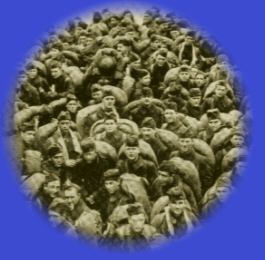 Combat Veterans Heading HomePublic attention turned to the problem of welcoming veterans home as early as 1943, when Roosevelt used the end of a July fireside chat on the progress of the war to warn the country against "waiting to do a hasty, insufficient and ill-considered job at the last moment." Mail to the White House suggested a warm response to Roosevelt's general proposals for mustering-out pay, unemployment insurance, educational benefits, and adequate medical care. Seventy percent of those responding to a 1944 Gallup Poll even offered to pay extra taxes for these veterans' benefits. However, the head of the VA, General Frank Hines, warned the president against expecting the country to let him solve the problem alone. "We again hear the same talk of high wages at home while the men are fighting abroad," Hines cautioned. These statements raised Hines's suspicions that another bonus crusade was in the making. The president still opposed adjustment compensation, but he had not helped his case by acknowledging in his fireside chat that servicemen "have been compelled to make greater economic sacrifice. . . than the rest of us." The president, it turned out, had little to fear in choosing to remain neutral during the subsequent legislative debates over the GI Bill. Rather than seizing on his words to legitimate the principles they had long espoused, American Legion officials intended to repackage these concepts to make them politically viable. This wartime generation, Harry Colmery, the original author of the GI bill and a former Legion commander, stated, "should be aided in reaching that place, position, or status which they had normally expected to achieve, and probably would have achieved, had their war service not interrupted their careers." But a new vocabulary emerged to explain the GI Bill. "How well we all know that the words adjusted compensation and pension are dynamite to many people," noted one Legion official. The American Legion's omnibus bill competed with 640 bills introduced in Congress to provide a solution to the veterans' problem. The freshness of the scars inflicted over the previous twenty years surfaced when veterans came to testify before congressional subcommittees. "You can remember that you and I came back as returning heroes. Nothing was too good for us. The streets were draped with flags and the people were cheering," Congressman Errett Scrivner (R-Kans.) recalled to Omar Ketchum, commander of the VFW. "That was the first day," Ketchum interjected. "Well, within the first month," Scrivner replied. "But it was not long after that that we were called every name under the sun." On the Senate side, American Legion Commander Warren Atherton spoke with confidence to the committee chair. "You, Senator [Bennett] Clark [D-Miss.]," he said, "having been the first national commander of the American Legion and knowing the conditions which prevailed for returning World War I veterans in 1917-18, realize the value of making this preparation." 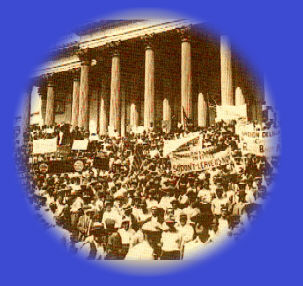 The Bonus Marchers in WashingtonThe Legion had some dramatic moments after ignoring advice that it chop up its GI Bill into more manageable chunks, rather than continue to press for a complete benefits package. In March, at the request of five smaller veterans' organizations, several congressmen introduced an adjusted compensation bill in lieu of the GI Bill of Rights. With this division in veterans' ranks threatening to confuse the nation over which path to pursue, the Legion rallied its members to make their wishes known. Behind-the-scenes negotiations brought the VFW into line behind the Legion bill. The Legion worked diligently to organize a grass-roots campaign and prepared promotional materials for its 12,000 posts to use in rallying local support. Posts received suggested radio interviews, press releases, and letters and telegrams for congressmen, as well as short trailer films for legionnaires to take to the local movie theater. The earlier decision of the Hearst newspaper chain to support the bill as a way to highlight the shortcomings of the Roosevelt administration's social welfare programs also helped influence public opinion in favor of the proposal. Inside the Legion command center in Washington, members mounted a huge wall chart to portray the results of their daily canvas of Congress and the work of the 149 House members who belonged to the Legion. On May 10, in a well-publicized ceremony on the steps of the Capitol, Legion officials delivered petitions bearing a million signatures to the House leadership. Congressman John Rankin (D-Miss.), a legionnaire, who chaired the House World War Veterans' Legislation Committee, provided the most gripping, nail-biting moments. The Senate passed an omnibus bill on March 24, but the House version remained mired in Rankin's committee until May 3. In April, the Mississippi congressman focused his objections on the bill's unemployment provisions. In public hearings, he recalled the "goldbrickers" he had known during World War I who would have relished a chance to loaf at government expense. Privately, Legion officials noted that, in executive sessions, Rankin was "using the line that it will result in too high remuneration without work for Negro veterans in the South." Rankin also wondered aloud whether adjusted compensation better served former farmers from the South and West who had no intention of attending college. Throughout this period, the Legion worked hard writing compromise drafts to appease Rankin. The draft of the bill finally reported out of Rankin's committee on May 3 limited educational and employment benefits and raised the maximum loan amount. The version that passed the House 387-0 on May 18 sharpened these modifications. In the joint Senate-House Conference Committee created to hammer out differences between the two omnibus bills, compromise came quickly on education and loan benefits. Deadlock soon developed, however, over a relatively minor issue: whether or not the VA should have supervisory or administrative responsibility over the Veterans' Employment Service. With the final conference committee vote set for the morning of June 10, 1944, Rankin refused to cast the proxy vote of an absent member in favor of supervisory responsibility. Legion officials raced to track down Congressman John S. Gibson, a Democrat who had returned to Georgia. Those enlisted in the search included a telephone operator, who rang his house every fifteen minutes, a local radio station, which put out a news alert for Gibson to call home, and the state police, who went on the lookout for his car. Returning home late in the evening after spending the day hunting, Gibson agreed to take an army flight back to Washington from nearby Waycross air base. This plan fell through when the only available plane succumbed to mechanical problems, but the officer in charge provided a car to a commercial air field in Jacksonville, Florida. After boarding a 2:20 A.M. flight to Washington, Gibson arrived in time to cast the key vote. In the final version of the bill, a board chaired by the administrator of Veterans' Affairs was established to monitor veterans' job placement by the U.S. Employment Service. The housing loan and unemployment compensation provisions of the GI Bill clearly owed a debt to New Deal innovations such as the long-term, low-interest mortgages first offered in 1933 by the Home Owners Loan Corporation, the unemployment compensation provisions of the 1935 Social Security Act, and the creation of the 1933 Veterans' Employment Service within the U.S. Employment Service. The largesse of the New Deal years also made the proposal seem less like special class legislation (the main objection FDR had to paying the bonus early), and more like a subset of the general social welfare assistance now available to Americans classified as deserving poor. The public and government intended simply to enfold veterans in the system of entitlements available to a broad cross-section of Americans. Dixon Wecter, in his path breaking study of veterans in 1944, spoke for the majority of Americans when he refused to see GI Bill-granted access to national health care as special class legislation. Wecter argued that the "broader ideas of social responsibility which have sprung with the New Deal" made national health insurance inevitable, "which means that [soon] the ex-soldier as civilian will share a universal protection." Although influential commentators like Wecter denied veterans the right to special entitlements, the notion of them as a specially disabled group had stuck. "The fact that selective service has become the basis for recruiting our armed forces - that a man's losses in time, opportunity, or health while in the service are no longer voluntary but risks exacted by the State-has fostered a greater sense of Federal responsibility in his retraining and reemployment," Wecter wrote. Foreshadowing the debate that would swirl around affirmative action programs in the late twentieth century, the question centered on whether veterans' benefits restored equality by rectifying past injustices or whether they bestowed advantages and created a specially entitled class. The public had sanctioned adjustment compensation as the former in the 1920s and rejected the bonus as the latter after the Bonus March. Commentators like Wecter soothed Americans with the idea that the majority of the benefits provided by the GI Bill simply leveled the playing field that the selective service system had made uneven, and that the remainder would soon be extended to non-veterans. In reality, the legislation created the most privileged generation in American history. 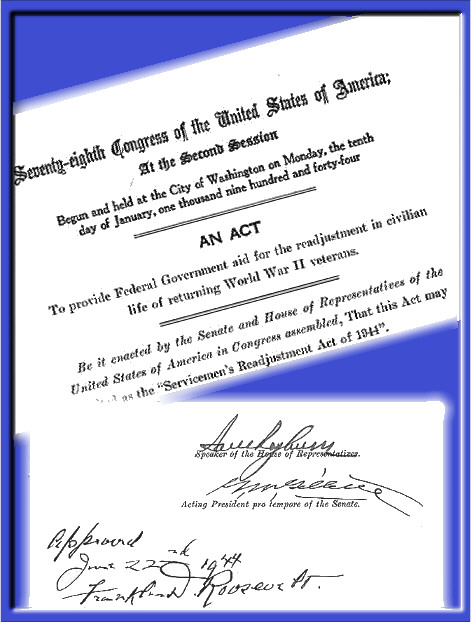 The GI Bill: Introduction & SignaturesIt is hard to exaggerate the importance of the GI Bill in twentieth century American history. For the first time, serving in the wartime military became a way to enter the middle class. The economic stability provided by the GI Bill in education, home ownership, and medical care came at the right historical moment in the life of both individuals and the nation. Until amended in 1945, the initial law required veterans who entered the service after age twenty-five to prove that the war had interrupted their education in order to receive more than a year of educational benefits. The original bill's creators correctly concluded that younger veterans had the best chance of using education to repair their civilian lives. Colmery warned that "many of the older group taken under selective service, leaving wife and children and sacrificing position and business[,] may have a more serious problem of readjustment than the younger ones. "The GI Bill's expansion of the VA's hospital system, coupled with easier access to government health care in the next few years, proved to be a more substantial way to help older veterans. Paradoxically, the men who had entered military service later in life had more health problems throughout their lives, even though they were less likely than younger recruits to have experienced combat in World War II. University education helped younger veterans advance because this opportunity came along at the right personal and historical moment. Giving free college tuition to men who as a group averaged only a sixth grade education would have made little sense after World War I. The discovery of this educational deficit, coupled with stricter child labor laws, had encouraged a new domestic emphasis on education in the interwar years. By World War II, the average serviceman had completed the second year of high school. This veteran could readily see how military service had prevented him from finishing high school or attending a college or technical school. Approximately 80 percent of the 2.2 million veterans who received a GI Bill-sponsored college education were returning students, while 5.4 million took vocational job training courses. An education as an engineer, accountant, or even a plumber meant little, however, without a job after graduation. Defying all predictions forecasting a new Depression, educated World War II veterans benefited from and contributed to a postwar economic boom that kept the unemployment rate below 5 percent. The singularity of this historical moment is underscored by life-course research on the Vietnam War. Military service did not have the same positive effect on the socioeconomic status of Vietnam veterans. Substantial aid to college-bound students in the 1960s and 1970s and scaled-back veterans' benefits meant that military service once again became time lost for veterans rather than the path to increased occupational and educational opportunities. As expected, the issue of adjusted compensation came up again after World War II, but the bonus concept had been discredited by its ineffectiveness as a relief measure and its earlier role in rallying veterans against the government, and little came of such proposals. The concept of compensating veterans for the hardships of living overseas and for the length of time they spent away from high-paying civilian wartime jobs remained relevant, however. The amount of mustering-out pay, for instance, differed for those serving at home and overseas, while education and unemployment benefits depended upon the length of one's service. 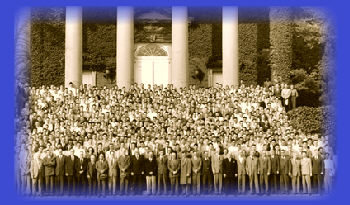 Bursting with Veterans -- 1947 | |||||
|
Sources and thanks: The author's assistance is greatly appreciated. Photos from the work, Syracuse University website and the Library of Congress. MH |
To find other Doughboy Features visit our |
Membership Information  Click on Icon |
For further information on the events of 1914-1918
visit the homepage of |
Michael E. Hanlon (medwardh@hotmail.com) regarding content,
or toMike Iavarone (mikei01@execpc.com) regarding form and function.
Original artwork & copy; © 1998-2000, The Great War Society
